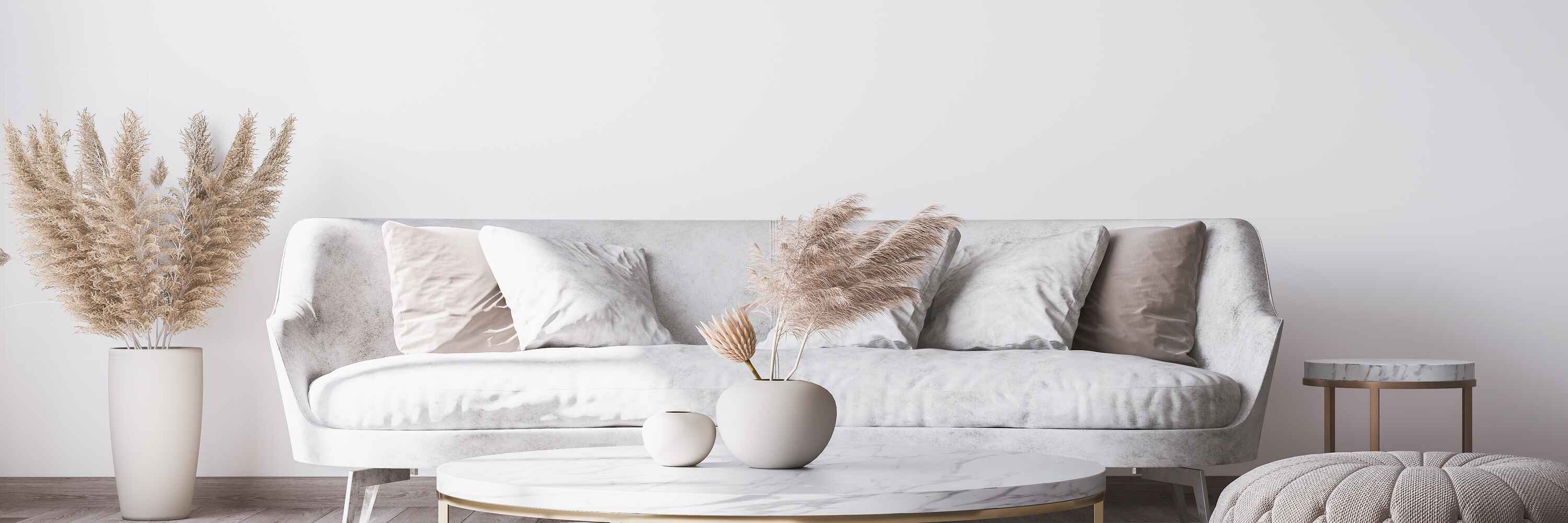Home Office: How to Create a Productive Environment at Home
March 30th, 2021
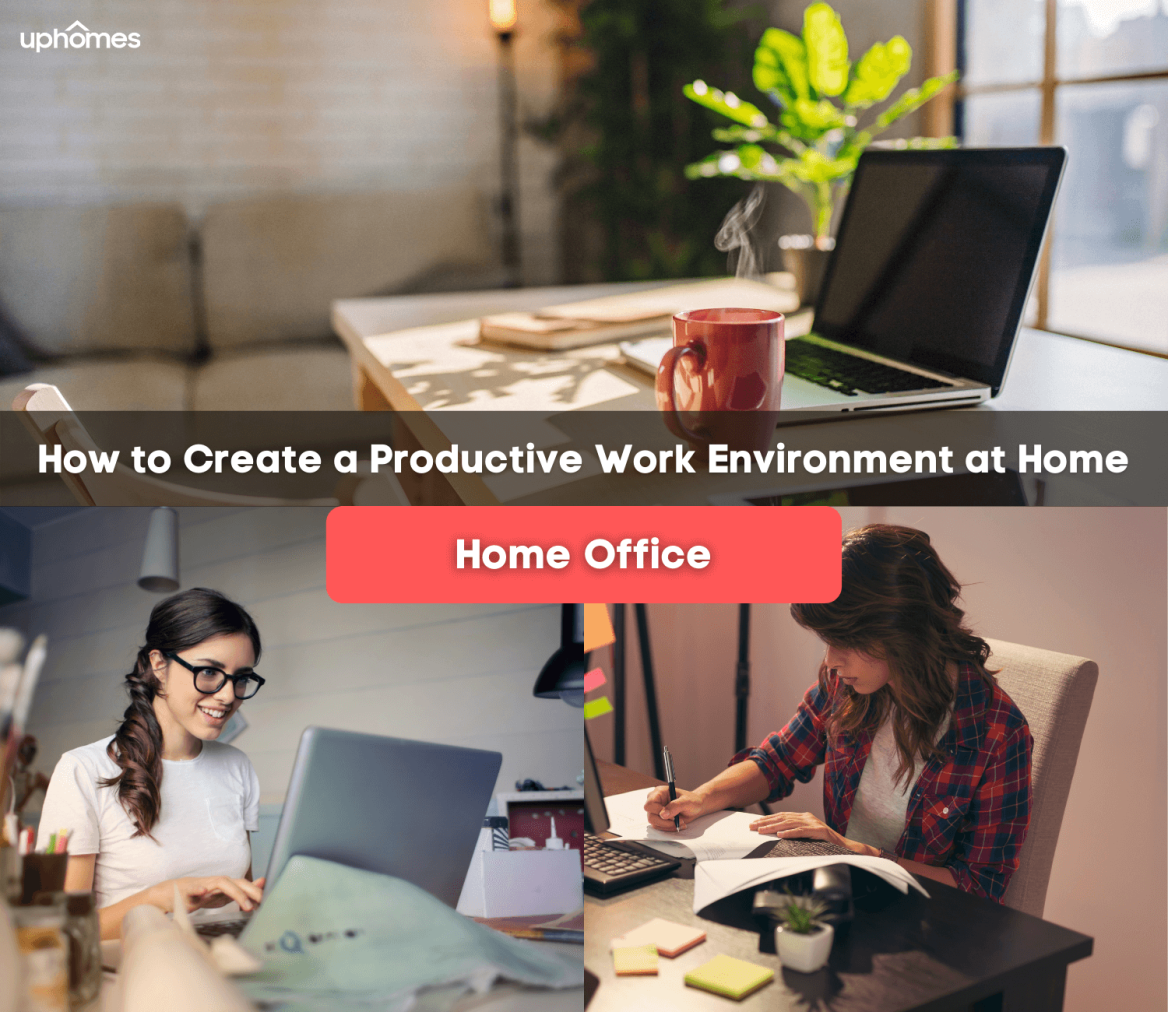
Home Office: How to Create a Productive Environment at Home
The average commute to work is 30-minutes one way and 60-minutes total per day - It's no wonder employees are more productive when working from their home office. Are people more productive when working from home?
The average remote worker spends 1.4 more days per month or 16.8 more days per year working than those who work from an office. That's an extra 3 work weeks per year!
So how does one create a home office for max productivity when working from home? It starts with creating the right work environment in your home.
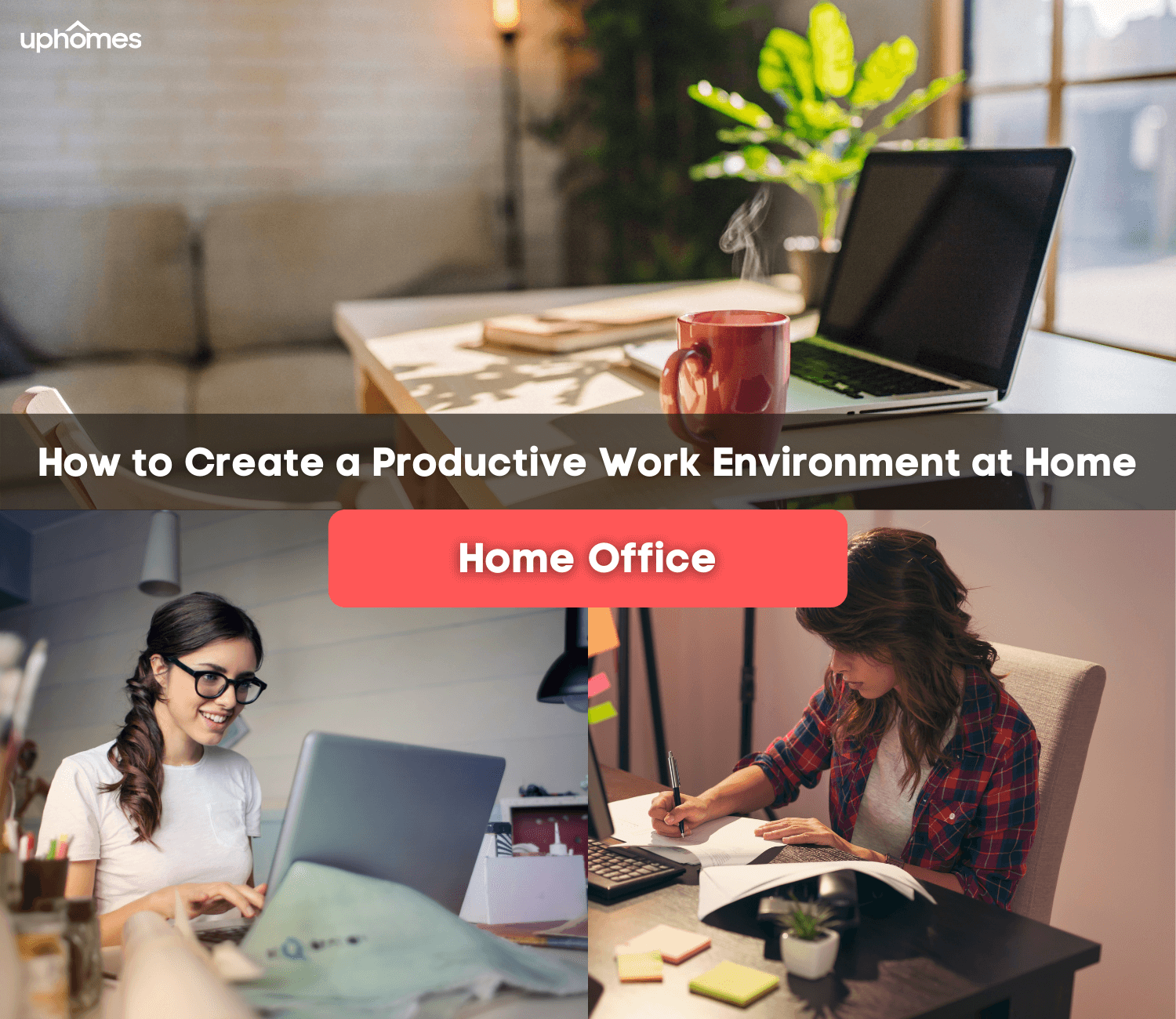
Some people can work from home and be much more productive than working in the office while others just can't seem to get started. To work from home, you have to have the discipline to be your own boss, whether you have your own business or you are an employee. One way to make things easier on yourself is to convert a spare room into your home office allowing yourself to use this room as your workspace. Some new construction homes are even being built with dual office setups to allow for people to work from home. You can take some steps, regardless of how productive you are, to make yourself even more productive.
Take Stock of Your Office Space
Make a list of items you need for your office space, then create your space. Your office should be arranged so that everything you need is within easy reach, including printers, scanners, paper, and office supplies. Set up a productive office in a spare room with office furniture that is comfortable for you.

Keep Your Space Free of Clutter
Lots of clutter means lots of distractions. You might think that you have to stop working and clean up the clutter. If you keep your office free of clutter as you work, you'll be less likely to stop working and pick up. Instead, you can keep your office decluttered as you work.
- Keep office supplies close by so you are not tempted to leave them on your desk.
- Invest in a shredder if you don't already have one. Make sure you choose a shredder with crosscut blades, and that the blades create small squares of paper. The smaller the shred, the harder it is for someone to try to put documents back together again. Any documents that you do not need to keep should be shredded as you finish with them. Notes to yourself, envelopes from the mail, junk mail, or anything else with personal information that you do not need to keep for taxes or work should be shredded immediately.
- Keep a small trash can within reach in your office so you won't have to get up to throw any trash away.
- Place an inbox and outbox on your desk or in a file drawer on your desk. As you receive documents that you need to do something with, such as bills to pay, put them in your inbox. Set a time to open and review anything in your inbox. After reviewing the documents, take immediate action on those that you can otherwise put back into your inbox.
- As you complete tasks, place any documents related to that task in the outbox. At the end of every day, file the documents and put outgoing mail in the mailbox.
Add Plants and Personal Items to Your Office
If plants calm you, add one or two plants to your office - it also improves your mental health when working from home. Don't bring in so many that your office looks cluttered. You can also add paintings and framed posters to the walls. If you have awards, frame them and add them to the walls. Don't crowd the wall with stuff – but add enough to give your office a comfortable, homey feel.
If you have room on your desk and can add a photo without making your desk look and feel cluttered, you might add a favorite photo that you can glance up and see.
Add Convenience to Your Office
If you have space, you might add a small fridge to hold drinks and cream for your coffee. It might also hold snacks that need refrigeration. You won't have to leave the office to quench your thirst or to stave off hunger when you need a snack, which means that whatever is going on in the rest of the house won't distract you from going back to work.
You can put a small coffee maker with a couple of coffee cups, sugar, and your coffee on top of the fridge to save space. You could also put a cabinet over the top of the fridge if you prefer to keep those items out of sight.
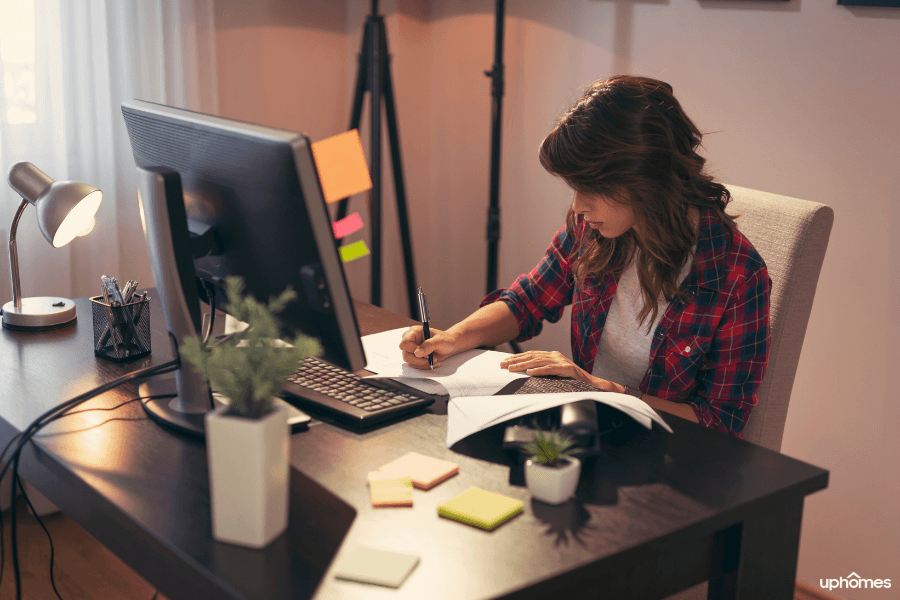
Add Comfort Items to Your Office
If noise in the background makes you more productive, add a television or a radio to your office. Keep the volume low enough so that it's not distracting, yet loud enough so you can hear it when you are not concentrating.
If you like a certain scent, you can burn a scented candle or incense to help increase productivity. Choose a scent that energizes you and makes you feel like you can conquer the world.
Create a Checklist
At the beginning of each day, create a checklist of everything you need to do. Once the list is created, order it by priority. Finally, divide the list by time. If you believe you can do the first few items on your checklist prior to lunch, separate those out. Draw a line under the last task and add the finish time.
As you complete a task, draw a line through it. With the list, you won't forget something you need to do, plus seeing each task crossed out tends to encourage you to cross out another project and shows you that you are making progress on your work.

Take Frequent Breaks
Even if your break is getting out of your chair to walk across the room to grab a bottle of water or soda, take a minute or two to stand before you sit back down. If you have a hard time giving your mind a break, set a timer for two or three minutes. While taking a break might not seem productive, giving your mind a break allows it to "reset" and become more productive.
Every Day Is Bring Your Pet to Work Day
When you are at home, you can bring your pet to work every day. Studies have shown that pets, especially dogs, make us relax and make us happy. Add a dog bed to your home office so your 'assistant' can help you throughout the day. A happier and more relaxed person is a more productive person since you can concentrate on your work and not whatever is worrying you today.
You might find a spot by your desk for your dog's favorite bed so it will be in the same room with you, but will be less likely to distract you by bringing its toys for you to throw.
Set Boundaries Between Personal Life and Work-Life
Unless you set boundaries between your personal life and work life, you won't be productive. Interruptions can break your train of thought, and you'll have to rework issues. If family members are home, let them know that they should not enter your office space unless you have an emergency.
If your job requires you to be on conference calls, you might want to put a sign on the door to let family members know you are on a conference call and there should be no interruptions except for life and death emergencies.
You should also let family members know that when you take a break, you can spend that break with them, but it is limited to the time you give yourself. For example, if you set a half hour for lunch, then you must return to your office after that half-hour. Many people in today's workplace are working from their home which means the need for more square footage is real.
Give Your Eyes a Break
Looking at a computer screen for hours on end is not good for your eyes. It also makes you tired. Every 20 to 30 minutes, take 30 seconds to look out of the window or look around the room. If you receive a phone call, try to keep your eyes off the computer. You might even look up at the television if it's far enough away to give your eyes a break.
Set Up Real Breaks
Most jobs give you a 10-minute break in the morning, a half-hour or hour for lunch, and another 10-minute break in the afternoon. Set a work schedule that follows this break schedule. Take a morning break of 10 to 15 minutes halfway between your start time and lunch, then again halfway between lunch and the end of your day.
Leave the office. Walk to the mailbox, sit on the porch, or even relax in your favorite chair in the living room. Take true breaks from work – don't even think about work while you are on your break.
During lunch, make a true lunch, whether you cook a light lunch or head out to a nearby café, or even run a quick errand on your lunch break. You'll need some energy food to keep you productive in the afternoon. And, speaking of food, you should eat a light breakfast before you start work. That will also give you some energy to get through the morning.
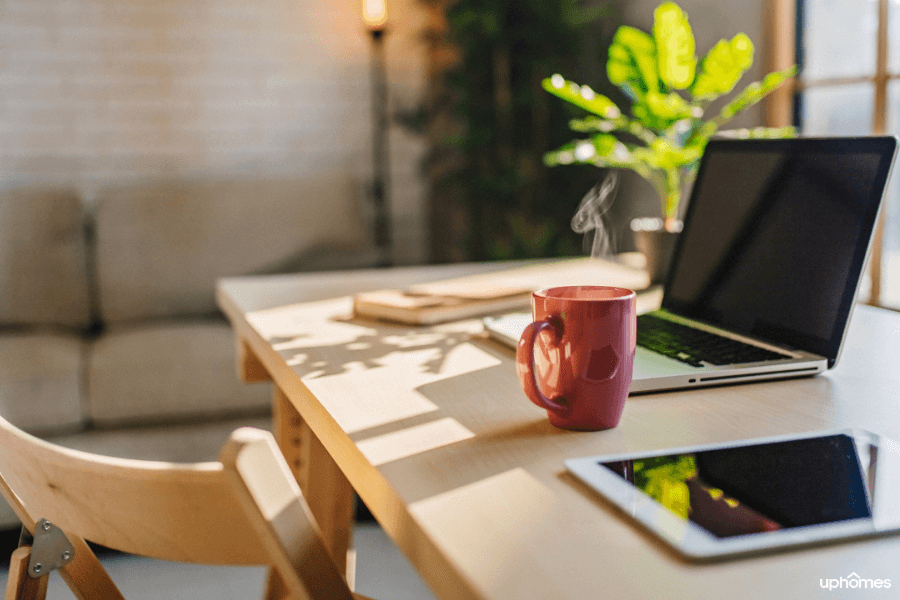
Dress for Success
This doesn't mean you have to get up and put a suit on every day – unless that is what motivates you. Some people don't feel as though they are working unless they are dressed up. If that's you, dress as if you were going to the office.
Others are more productive when they can dress comfortably. If sweats or shorts and a t-shirt are what do it for you, then that's the way you should dress. Your success isn't always going to be the same as someone else's success. Being comfortable while you work is what makes you more productive.
If you frequently take video calls, there's no rule that says you can't wear a shirt and tie or a nice top with sweats or shorts – as long as you're not taking that video call standing up where the other person can see that you're not 100 percent dressed to the nines.
Control the Temperature in Your Office
Most offices are set to 68 to 71 degrees Fahrenheit since that seems to be what makes most people productive. If that temperature makes your fingers and feet cold, you're going to be distracted. Set the temperature a little higher. If you like your house at those temperatures, but prefer a warmer temperature when you are working, you can add a small space heater in the office to bump the temperature up.
Likewise, if you prefer cooler temperatures – set your thermostat to a cooler temperature. If it's too cold for others in your home, you might consider investing in a ceiling fan for the office, or even a small air conditioner. You can also buy a zoning system for your HVAC system. It works by adding thermostats in each room with zone controls via automatic dampers in the ducts for each room.
Another option is installing a ductless system in the office. These systems can provide individual heating and cooling for each room.
Ergonomics in Your Workspace
You can reduce strain, stress, and overexertion by making sure your workspace is set up ergonomically. Make sure you choose a chair that supports your back and hips, and that your desk is the appropriate height for your neck and arms. A sit/stand desk allows you to adjust it to sit or stand while you are working, which can significantly increase productivity for some.
Take Brain Breaks
If you are working on something that requires a lot of concentration, the regular breaks you set might not be enough. Keep a distraction nearby – but not in sight – so that it's easy to reach. If you find yourself nodding off or not being able to concentrate, take a few minutes to play a game on your phone, do some light exercises, or turn up the radio to listen to music for a few minutes.
Choose something you enjoy and that you can do in three to four minutes just to give your brain a break from working on the project. You'll find that you will be able to concentrate better if you stop what you are doing for that few minutes.
Turn Your Cell Phone Off or Leave it in Another Room
Phone calls can be extremely distracting. If you must have your cell phone with you for calls from your children's school or important work-related calls, set ring tones for specific numbers. Learn the ring tones so you know which calls you can ignore and which ones you absolutely need to answer.
Emails and Social Media
You might be tempted to check your email or social media constantly throughout the day. Instead, create rules around things that may distract you from being productive. Emails and social media are two distractions that will take away from your productivity by distracting you from the tasks at hand. If you are spending time replying to emails or engaging on social media you are not tackling your to-do list!
Once you have everything set up and rules for your family and yourself, you can be more productive working at home than you are in the office. Working from home reduces interruptions from your boss and co-workers, plus reduces the energy you use to listen to what is going on in the background in an office full of people.
Final thoughts on Creating a Productive Work Environment from your Home Office
From anxious pets to babies, to the delivery of packages there are distractions everywhere when working from home. It's important to stay disciplined on your work otherwise your day will get away from you and you'll have more to do the following day. Creating a productive work environment at home doesn't have to be difficult. With the tips in this article, you will be able to create a home office that leads to a productive workday!

Ryan Fitzgerald
Hi there! My name is Ryan Fitzgerald, and I am a REALTOR®. My goal is to help you learn more about real estate through our Real Estate Blog! Hopefully, you enjoyed the above blog post and it found a way to provide help or value to you. When you're ready to buy or sell a home of your own let us know here. Please feel free to join the conversation by dropping us a comment below.

